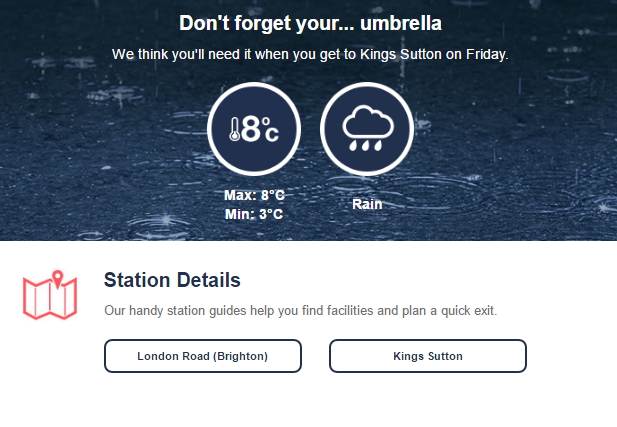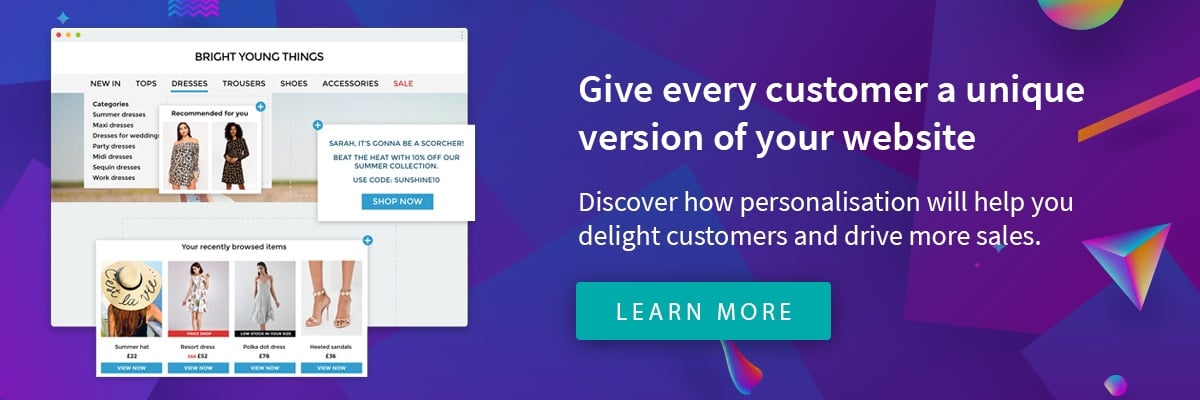What did you chat to your colleague about when you were making coffee earlier? Our money is on the weather.
Commenting on the weather is a British stereotype we can’t help but stay true to. But how can you make use of this in your marketing?
In this blog post, we explore how to use weather-based personalisation to improve the experience you offer your customers and increase online revenue.
Why does weather-based personalisation matter?
There’s a reason the weather is our go-to small talk topic. When you first meet someone, you may be struggling for things to say. If you’ve both just been drenched in the rain, you suddenly have something to bond over.

Weather-based personalisation allows you to make use of this human way of building rapport in your marketing and relevancy in your website experience. Real-time personalisation technology allows you to personalise your website and email content based on location-specific weather data.
Weather-specific messages are hyper relevant to each customer and seem a lot more personal. For this reason, they are more likely to resonate and compel customers to act.
But weather-based personalisation does more than increase emotional engagement. It also empowers you to take advantage of weather-specific buying intentions and behaviours.
According to research by The Weather Channel, the weather affects consumers in three ways. Changes in the weather may cause retail consumers to:
- postpone or bring forward planned purchases
- buy (or not buy) a product immediately because of an immediate need
- substitute the purchase of one product or service for another
Another study found that even major purchases like car and houses are affected by weather.
Consumers tended to overvalue warm-weather features of cars and houses when it was warm. Vice versa, they overvalued cold-weather features when it was cold. You’re more likely to end up with a house with a fireplace if you buy it when its cold!
Weather-based personalisation is underused
Surprisingly few brands take advantage of weather-based personalisation, unaware of its potential to increase engagement and drive sales.
Paul Walsh, weather and climate strategist for The Weather Channel notes that despite weather being “an important driver of consumer sentiment and activity”, it isn’t “as well-known and leveraged as it should be.”
Aware that weather-based personalisation was an untapped opportunity, in 2017 Amazon launched a weather-reactive store called #NowItsSummer.
The store makes use of a wealth of weather-based sales data to recommend products that will help consumers make the most of changeable British summer weather.

How to use weather-based personalisation
There are a number of ways travel and retail brands can take advantage of weather personalisation. Here are a few ideas to get you started.
Personalised product recommendations
Personalised product recommendations are a smart way to cross-sell and upsell. This helps increase average order value and customer lifetime value. You can use this tactic across your emails and website.
Personalisation tools allow you to curate recommendations based on user data. These could be crowd-sourced best sellers or recommendations based on previous purchases.
Theming your product recommendations according to the weather is a smart way to incorporate weather personalisation. For example, recommend cold weather garments when it’s chilly out but T-shirts if it’s hot.
If your products are not obviously linked to temperature, compare your sales data with weather reports to spot trends. For example, you might find sales of chocolate go up in cold weather. If so, you know what to recommend when the temperature drops.
Here’s an example from a sunglasses retailer of weather-personalised product recommendations in action:

Personalised homepage
Personalisation is about more than just sticking a name in an email these days. With more brands using basic personalisation, smart brands are using personalisation that’s a bit more intelligent.
It might sound fancy, but intelligent personalisation needn’t be more taxing for your team. Our personalisation platform allows you to insert smart blocks onto your homepage so you can dynamically serve personalised content to individual users.
Our weather data integration means you can create weather-relevant promotions as soon as your customers hit your homepage, no matter where they are in the world. This is a sure-fire way to grab your customer’s attention. It’s an unexpected level of detail that will surprise and delight.
We love this example of a weather personalised homepage from Very. Come rain or shine, the fashion brand has the right look for its customers:

Personalised homepage when it’s sunny

Personalised homepage when it’s raining
Personalised journey details
A savvy way to use weather-based personalisation if you’re a travel brand, is in your journey details emails. These automated emails get triggered a day or two before a customer departs.
Adding weather-based personalisation makes your journey detail email hyper relevant. Make use of this tactic and your customers will start to think of you like a helpful travel companion.
If it’s going to be raining when they travel, remind them to bring a brolly. Bright sunshine? Make sure they pack their suncream.
Here’s an example of this simple but effective tactic in action from Trainline:

Personalised call-to-action
Another way to use weather-based personalisation is to in your call-to-action (CTA). This makes your CTA contextually relevant and more emotionally engaging. Qualities that make people much more likely to click on it.
In this example from Topshop, the weather-personalised CTA “Shop for rain” is likely to resonate with customers more than a generic invitation to browse products:

Weather-triggered emails
Another way to integrate weather-based personalisation into your marketing strategy is by setting up a serious of weather-triggered email automations.
Triggering emails based on weather conditions is a clever way to prompt recipients to shop for relevant products. This works well across retail and travel.
Travel brands can set up email automations triggered by bad weather to tempt customers to browse getaways in sunnier climes. Retailers can promote products that are either obviously linked or sell best in that weather.
Here’s an example prompting customers to shop for travel safety products to keep them safe on the roads in chilly conditions:

Weather-specific discount
Whatever the weather, you can turn it to your advantage through weather-specific discounts.
This can work for you whether your products are weather-related or not. Use discounting to set up a new association in your customer’s mind. If you always reduce a certain product when it’s raining, next time it rains your brand will pop into your customer’s minds.
Here’s an example from a restaurant offering a “crummy weather discount” on pizza when it’s sweltering hot. (We’re guessing they aren’t UK-based if they consider hot temperatures crummy!)

Takeaway
Now we’ve equipped you to turn weather into a marketing opportunity, we hope your team gets unfathomably excited next time it rains. (That’ll confuse the sales team.)
The weather personalisation tactics we’ve covered are easy to implement with the right personalisation tools in place. To see ours in action, make friends with the button below.

